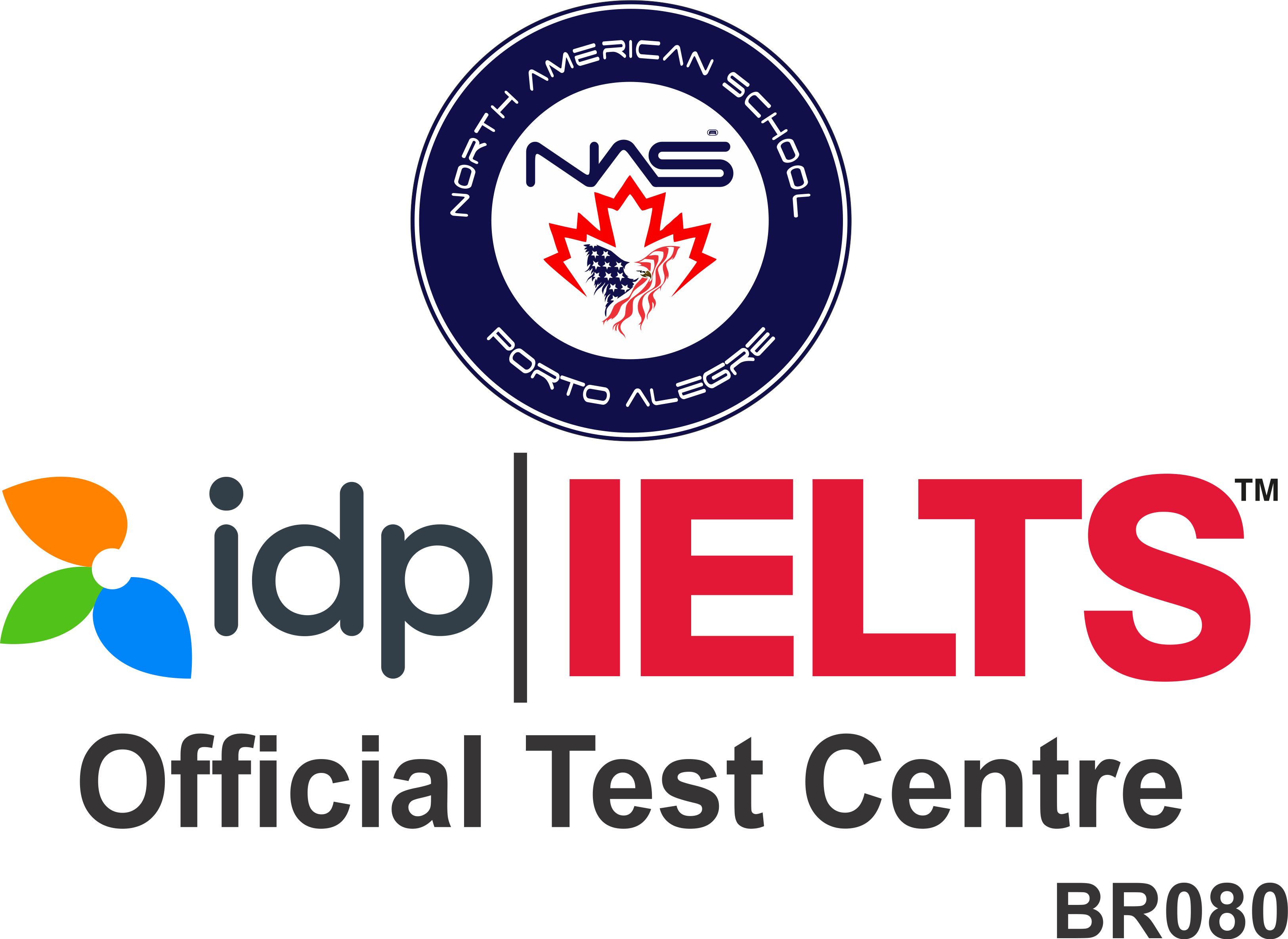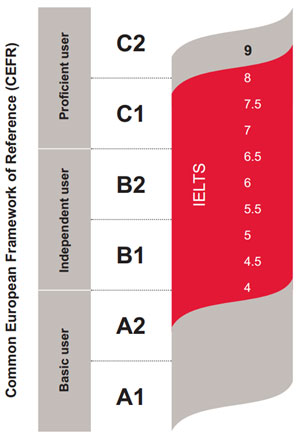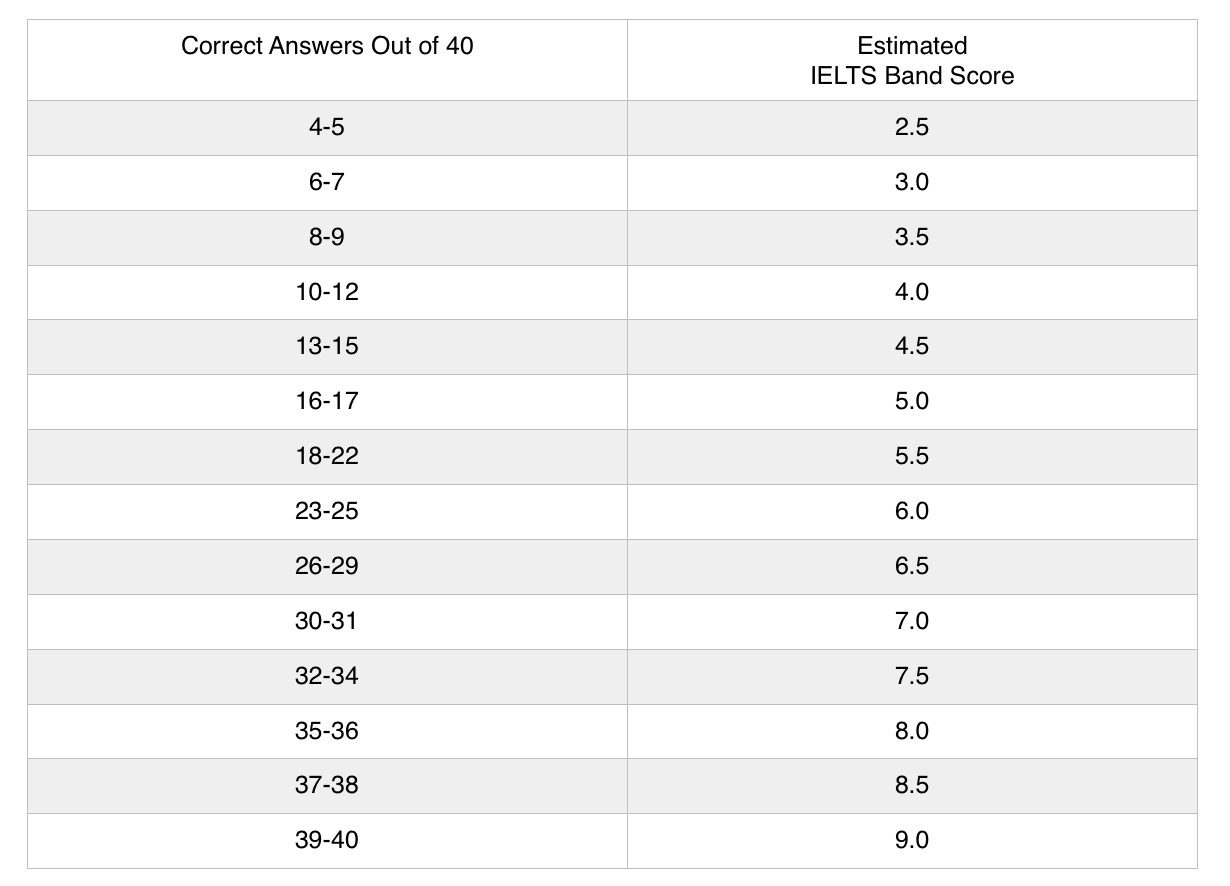
NORTH AMERICAN SCHOOL
THE OFFICIAL IELTS TEST CENTRE IN RIO GRANDE DO SUL
INFORMAÇÕES IMPORTANTES AOS CANDIDATOS
Se você fez o Exame IELTS em nosso centro, North American School – ANTES de 15 de abril de 2022 e você deseja:
- Solicitar um TRF Extra (Test Report Form) ou Solicitar um EOR (Enquire on Results) por favor contate nossos colegas no British Council – Brasil – em São Paulo:
Para um TRF Extra CLIQUE AQUI.
- Retirar o seu primeiro TRF Impresso, por favor nos contate em: ielts.adm@northamericanschool.com ou Via Whatsapp: +55 51 995053001
Se você fez o Exame IELTS em Nosso Centro, NorthAmerican School – APÓS 15 de abril de 2022 e você precisa de algum suporte ou informação. por favor nos contate diretamente em ielts.adm@northamericanschool.com ou Via Whatsapp: +55 51 995053001
IMPORTANT INFORMATION TO IELTS TEST TAKERS
If you have taken the IELTS exam at our Centre, North American School – BEFORE 15 April 2022 and you wish to:
- Ask for an Extra TRF (Test Report Form) or request an EOR (Enquiry on Results) please contact our colleagues at British Council – Brazil – São Paulo:
- Collect your First printed TRF, please contact us at ielts.adm@northamericanschool.com or Via Whatsapp: +55 51 995053001
If you have taken the IELTS exam at our Test Centre AFTER 15 April 2022 and you need any support, please contact us directly at ielts.adm@northamericanschool.com or Via Whatsapp: +55 51 995053001
Único Centro Certificado pelo
IDP – Australia para aplicação do Teste IELTS
no Rio Grande do Sul.
Centre BR080
Escolha a data do seu teste e inscreva-se:
IELTS Test em Porto Alegre clique aqui
Tem Dúvidas?
Mande um Whatsapp
IELTS – International English Language Testing System
Exame de língua inglesa mais popular do mundo! Mais de 2 milhões de pessoas fazem o IELTS a cada ano.
O IELTS abre portas – ele pode ajudar você a viver, estudar e trabalhar no mundo todo. Mais de 8 mil organizações ao redor do mundo aceitam o IELTS, inclusive instituições governamentais, acadêmicas e agências de emprego. É o único exame de língua inglesa aceito para fins de imigração por todos os países que exigem um. O IELTS é projetado para ajudar você a utilizar o inglês em sua nova vida no exterior. Em menos de 3 horas, ele avaliará seus conhecimento de inglês em quatro segmentos: listening, reading, writing e speaking. A forma mais eficaz de testar suas capacidades de conversação em inglês é face a face. O IELTS é o exame de língua inglesa de maior aceitação com um teste de speaking individual para avaliar suas habilidades de comunicação na língua inglesa.
Concebido por especialistas na avaliação da língua inglesa e digno de confiança ao redor do mundo, você pode ter certeza de que o IELTS proporcionará uma avaliação justa e consistente de seus conhecimentos de inglês. O IELTS é uma propriedade conjunta do British Council, IDP: IELTS Australia e Cambridge English Language Assessment e é aplicado em mais 140 países. Se você estiver solicitando um visto para mudar-se ou permanecer no Reino Unido, existe um exame IELTS para você. Saiba mais na página IELTS for UK Visas and Immigration.
A NORTH AMERICAN SCHOOL prepara você para seu teste IELTS, através de um curso elaborado com materiais de alta qualidade produzidos pela editora PEARSON ELT e CAMBRIDGE .
CURSO PREPARATÓRIO IELTS NORTH AMERICAN SCHOOL
PREPARE FOR IELTS
IELTS TEST Characteristics
IELTS Academic and IELTS General Training are designed to cover the full range of ability from non-user to expert user. The Academic version is for test takers who want to study at tertiary level in an English-speaking country or seek professional registration. The General Training version is for test takers who want to work, train, study at a secondary school or migrate to an English-speaking country.
The difference between the Academic and General Training versions is the content, context and purpose of the tasks. All other features, such as timing allocation, length of written responses and reporting of scores, are the same.
IELTS Academic and General Training both incorporate the following features:
- IELTS tests the ability to listen, read, write and speak in English.
- The speaking module is a key component of IELTS. It is conducted in the form of a one-to-one interview with an examiner. The examiner assesses the test taker as he or she is speaking. The speaking session is also recorded for monitoring and for re-marking in case of an appeal against the score given.
- A variety of accents and writing styles have been presented in test materials in order to minimize linguistic bias.
- IELTS is developed by experts at Cambridge English Language Assessment with input from item writers from around the world. Teams are located in the USA, Great Britain, Australia, New Zealand, Canada and other English-speaking nations.
- Band scores are used for each language sub-skill (Listening, Reading, Writing, and Speaking). The Band Scale ranges from 0 (“Did not attempt the test”) to 9 (“Expert User”).
IELTS Test Structure
Modules
There are two modules of the IELTS:
- Academic Module
- General Training Module
There is also a separate test offered by the IELTS test partners, called IELTS Life Skills:
- IELTS Academic is intended for those who want to enroll in universities and other institutions of higher education and for professionals such as medical doctors and nurses who want to study or practise in an English-speaking country.
- IELTS General Training is intended for those planning to undertake non-academic training or to gain work experience, or for immigration
- IELTS Life Skills is intended for those who need to prove their English speaking and listening skills at Common European Framework of Reference for Languages (CEFR) levels A1 or B1 and can be used to apply for a ‘family of a settled person’ visa, indefinite leave to remain or citizenship in the UK.
The IELTS test has four parts
- Listening: 30 minutes (PLUS 10 MINUTES’ TRANSFER TIME IN THE PAPER BASED VERSION – NO EXTRA TIME IN THE COMPUTER DELIVERED VERSION)
- Reading: 60 minutes
- Writing: 60 minutes
- Speaking: 11–14 minutes
The test total time is: 2 hours and 45 minutes.
Listening, Reading and Writing are completed in one sitting. The Speaking test may be taken on the same day or up to seven days before or after the other tests.
All test takers take the same Listening and Speaking tests, while the Reading and Writing tests differ depending on whether the test taker is taking the Academic or General Training versions of the test.
Listening
The module comprises four sections, with ten questions in each section. It takes 40 minutes: 30 – for testing, plus 10 for transferring the answers to an answer sheet.
Sections 1 and 2 are about every day, social situations.
- Section 1 has a conversation between two speakers (for example, a conversation about travel arrangements)
- Section 2 has one person speaking (for example, a speech about local facilities).
Sections 3 and 4 are about educational and training situations
- Section 3 is a conversation between two main speakers (for example, a discussion between two university students, perhaps guided by a tutor)
- Section 4 has one person speaking about an academic subject.
Each section begins with a short introduction telling the test taker about the situation and the speakers. Then they have some time to look through the questions. The questions are in the same order as the information in the recording, so the answer to the first question will be before the answer to the second question, and so on. The first three sections have a break in the middle allowing test takers to look at the remaining questions. Each section is heard only once.
At the end of the test students are given 10 minutes to transfer their answers to an answer sheet. Test takers will lose marks for incorrect spelling and grammar.
Reading
The Reading paper has three sections and texts totaling 2,150-2,750 words. There will be a variety of question types, such as multiple choice, short-answer questions, identifying information, identifying writer’s views, labeling diagrams, completing a summary using words taken from the text and matching information/headings/features in the text/sentence endings. Test takers should be careful when writing down their answers as they will lose marks for incorrect spelling and grammar.
Texts in IELTS Academic
Three reading texts, come from books, journals, magazines, newspapers, and online resources written for non-specialist audiences. All the topics are of general interest to students at the undergraduate or postgraduate level.
Texts in IELTS General Training
- Section 1 contains two or three short texts or several shorter texts, which deal with everyday topics. For example, timetables or notices – things a person would need to understand when living in an English-speaking country.
- Section 2 contains two texts, which deal with work. For example, job descriptions, contracts, training materials.
- Section 3 contains one long text about a topic of general interest. The text is generally descriptive, longer and more complex than the texts in Sections 1 and 2. The text will be taken from a newspaper, magazine, book or online resource.
Writing
The Writing paper has two tasks which must both be completed. In task 1 test takers write at least 150 words in about 20 minutes. In task 2 test takers write at least 250 words in about 40 minutes. Test takers will be penalized if their answer is too short or does not relate to the topic. Answers should be written in full sentences (test takers must not use notes or bullet points).
IELTS Academic
- Task 1: test takers describe a graph, table, chart, or diagram in their own words.
- Task 2: test takers discuss a point of view, argument, or problem. Depending on the task, test takers may be required to present a solution to a problem, present and justify an opinion, compare and contrast evidence, opinions, and implications, and evaluate and challenge ideas, evidence, or an argument.
IELTS General Training
- Task 1: test takers write a letter in response to a given everyday situation. For example, writing to an accommodation officer about problems with your accommodation, writing to a new employer about problems managing your time, or writing to a local newspaper about a plan to develop a local airport.
- Task 2: test takers write an essay about a topic of general interest. For example, whether smoking should be banned in public places, whether children’s leisure activities should be educational, and how environmental problems can be solved.
Speaking
The speaking test is a face-to-face interview between the test taker and an examiner.
The speaking test contains three sections.
- Section 1: introduction and interview (4–5 minutes). Test takers may be asked about their home, family, work, studies, hobbies, interests, and reasons for taking the IELTS exam as well as other general topics such as clothing, free time, computers, and the internet.
- Section 2: long turn (3–4 minutes). Test takers are given a task card about a particular topic. Test takers have one minute to prepare to talk about this topic. The task card states the points that should be included in the talk and one aspect of the topic which must be explained during the talk. Test takers are then expected to talk about the topic for 2 minutes, after which the examiner may ask one or two questions.
- Section 3: discussions (4–5 minutes). The third section involves a discussion between the examiner and the test taker, generally on questions relating to the theme that they have already spoken about in Section 2.
Scoring
Test takers receive a score for each test component – Listening, Reading, Writing and Speaking. The individual scores are then averaged and rounded to produce an Overall Band Score.
Band scale
There is no pass or fail. IELTS is scored on a nine-band scale, with each band corresponding to a specified competence in English. Overall Band Scores are reported to the nearest half-band.
The following rounding convention applies: if the average across the four skills ends in .25, it is rounded up to the next half band, and if it ends in .75, it is rounded up to the next whole band.
The nine bands are described as follows:
IELTS and the CEFR
For more information on how IELTS band scores correspond to levels on the Common European Framework of Reference for Languages (CEFR), please see the official conversion diagram on the IELTS website.
Conversion table
This table can be used to convert raw scores (out of 40) to band scores (out of 9). This helps test takers understand how many correct answers they need to achieve a particular band score. This chart is a guide only because sometimes the scores adjust slightly depending on how difficult the test is.
A Test Report Form is posted to test takers 13 days after their test. It shows:
- An Overall Band Score (from 1-9)
- A band score (from 1-9) for each section of the test (Listening, Reading, Writing, and Speaking)
- Whether IELTS Academic or General Training was completed
- The test taker’s photo, nationality, first language, and date of birth.
Test takers receive one copy of their Test Report Form, apart from test takers who are applying to the Department of Citizenship and Immigration Canada (CIC) or UK Visas and Immigration (UKVI) who receive two copies.










